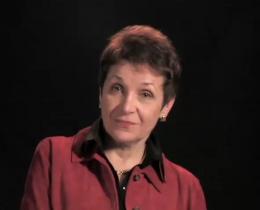If someone had said to me, “Be on the lookout tonight, Caroline, because someone is going to experience a spontaneous healing in your audience,” how would I have reacted? And at whom would I have looked? Would I have cast my attention to the two people in wheelchairs? Would I have looked for a sick child, because that’s got a certain Madonna-and-Child quality to it? Would I have asked for a show of hands to count how many people were ill, just to see how many subjects were in the running? I don’t know what I would have done. But a healing did happen that night while no one was looking.
The evening was part of a tour to promote my book, Entering the Castle. It was planned as the usual type of tour event, at which I introduce the book, chat about it for a couple of hours, answer some questions, and then autograph copies. But that’s not what happened on this evening. It started out that way, yet as I began to describe the “interior castle,”—the image Saint Teresa of Ávila used to beautifully describe the inner soul—I could tell that my words were not communicating its power or mystical significance. The people in the audience were simply not relating to the seductive power of their souls through words, and it was obvious that all the metaphors and analogies and poetic descriptions would only continue to fall short. In fact, lecturing about the nature of soul grew more frustrating with each passing minute, as I could tell that for my audience, “soul” itself was just a mental concept, a word without an experience attached to it. How could anyone relate to a description of a mystical experience? How could I possibly tell these people to get enthusiastic about a place they had never experienced? Words cannot get you to experience Paris, can they?
I began to realize that my listeners were craving an actual mystical experience, or as close as they could come to one. They didn’t want me to talk about the interior castle; they wanted to enter their own interior castles. I looked at this audience of more than 800 people and thought, “How am I going to do this without prayer?” Teresa was clear in her writings that the only way into one’s interior castle is through prayer and inner devotion. But my experience through the years had consistently been that although audiences were comfortable with meditation, guided imagery, moments of silence, and even terms like the Divine, the Goddess, and the Great Spirit, mention prayer or God and feathers got ruffled. “That’s too Catholic,” I have been told on more occasions than you can imagine—and though I’m not exactly a fan of the Vatican, I do come from a Catholic background. As a result, I had never introduced prayer into my workshops, not even moments of silence or meditation.
That evening I had to confront this ironclad policy. I knew that if I simply told my audience, “Close your eyes, sit back, and listen to my words as I lead you into your castle,” not only would I be dishonoring everything I knew about the mystical journey, but these eager people would also be denied an opportunity to experience something quite tranquil and authentic within them. I knew that the transformative link that drew a person “out of the mind” and into an altered state of consciousness, however slight and however brief, was prayer and that without prayer, the entire exercise into the castle—this metaphor of the soul—would be no more than a mental visualization. For me, that dishonored the very essence of the mystical experience.
To be clear, I differentiate between what I call a “mystical journey” and a “mystical experience.” A mystical journey is an inner exercise scripted with language that is specifically soul-focused. That is, instead of saying, “Relax and breathe into your energy,” as I might do in a different kind of guided meditation, I instruct people to “breathe into a field of grace.” I direct them into their “interior castle,” their inner soul, through prayer, not relaxation. I use the vocabulary of the soul and the sacred. A mystical experience, on the other hand, cannot be self-initiated. Rather, it is a spontaneous occurrence in which an individual is consumed into an altered state of divine consciousness.
So I told the audience that the journey into the interior castle required prayer and grace—not ordinary prayer, as in prayers of petition or repetition, but the type of prayer that withdraws your attention from external distractions and from your five senses. The audience was more than willing, and so, for the first time in my career, I led 800 people on their maiden journey into their interior castle.
As I continued the castle meditation exercise, the atmosphere in the room began to change. One way I can describe this is to say that it felt as if everyone had relaxed their shoulders and jaws at the same time. The tension was gone and its absence was palpable. I realize now that the collective sharing of prayer and opening to the experience of channeling grace had created a unified field of grace, generating a mystical atmosphere ripe for the experience of healing. A field of grace emerges when people come together in prayer or for acts of good intention, such as helping others after disasters. You can sense the absence of negativity in a field of grace, for example, and though it may not last long, the sensation that negativity has evaporated is akin to the absence of psychic tension, as if a soft harmonious breeze has filled the room. Everyone settles into an effortless place of calm and without being led into forming a chorus of breathing together, they silently unite into one whole breath. Such is the absence of negativity and rarely do people emerge rapidly from such inner tranquility. They want to reside in this grace as long as they can, not because they recognize it as grace but because for a small second, they are aware that they are experiencing a calmness that is not self-generated or contrived or imagined. It is a calmness that has been bestowed upon them and this is a calmness they will seek to return to again and again.
After the exercise, few wanted to leave their chairs, which is quite something in a room of 800 people. The silence in the room was not an ordinary one, but a soothing, healing silence that had penetrated deeply into the stressful minds and hearts of the audience, and they wanted to remain in this grace-filled quiet for as long as they could. Finally, I had to begin to sign books, so I thanked everyone, left the stage, and went to the signing table.
Hundreds of people lined up for inscriptions. It’s impossible to have a conversation with everyone, even though I want to because I am so grateful to see each person. Precisely because each person in that line who has bought a book wants to say something to me or ask me a question, there is always a “bad cop,” so to speak, someone who gently encourages people to keep moving. On this evening, when I was nearly done, a woman walked up behind me, somehow bypassing the vigilant bad cop, and said, “I’ve suffered with chronic pain for 20 years in my shoulders, my back, and my hands. I’ve never, ever been out of pain in all that time. I don’t know what just happened to me or how it happened, but my pain is gone, and somehow I know it is gone forever. I thought you would want to know that.”
She told me this while I was signing a book for someone else. I looked up to see her face. Shimmering with awe, she whispered, “Thank you,” and left. I wanted to run after her and ask, “Who are you? Tell me more about what happened,” but I couldn’t leave the book-signing table. And then she was gone.




